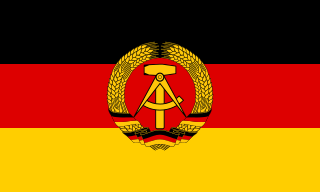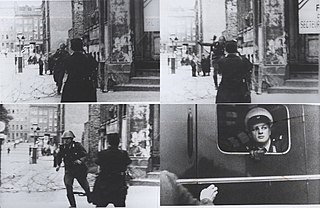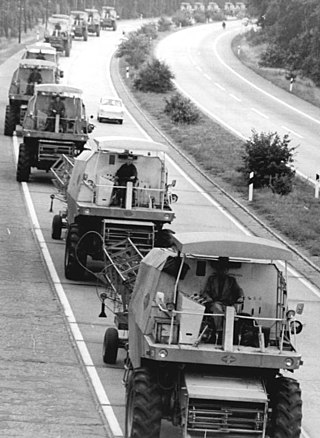
The Eastern Bloc, also known as the Communist Bloc (Combloc), the Socialist Bloc, and the Soviet Bloc, was an unofficial coalition of communist states of Central and Eastern Europe, Asia, Africa, and Latin America that were aligned with the Soviet Union and existed during the Cold War (1947–1991). These states followed the ideology of Marxism–Leninism, in opposition to the capitalist Western Bloc. The Eastern Bloc was often called the "Second World", whereas the term "First World" referred to the Western Bloc and "Third World" referred to the non-aligned countries that were mainly in Africa, Asia, and Latin America but notably also included former pre-1948 Soviet ally Yugoslavia, which was located in Europe.

The five-year plans for the development of the national economy of the Union of Soviet Socialist Republics (USSR) consisted of a series of nationwide centralized economic plans in the Soviet Union, beginning in the late 1920s. The Soviet state planning committee Gosplan developed these plans based on the theory of the productive forces that formed part of the ideology of the Communist Party for development of the Soviet economy. Fulfilling the current plan became the watchword of Soviet bureaucracy.

In the USSR, during the eleven-year period from the death of Joseph Stalin (1953) to the political ouster of Nikita Khrushchev (1964), the national politics were dominated by the Cold War, including the U.S.–USSR struggle for the global spread of their respective socio-economic systems and ideology, and the defense of hegemonic spheres of influence. Since the mid-1950s, despite the Communist Party of the Soviet Union (CPSU) having disowned Stalinism, the political culture of Stalinism — a very powerful General Secretary of the CPSU—remained in place, albeit weakened.

The Socialist Republic of Romania was a Marxist–Leninist one-party socialist state that existed officially in Romania from 1947 to 1989. From 1947 to 1965, the state was known as the Romanian People's Republic. The country was an Eastern Bloc state and a member of the Warsaw Pact with a dominant role for the Romanian Communist Party enshrined in its constitutions. Geographically, RSR was bordered by the Black Sea to the east, the Soviet Union to the north and east, Hungary and Yugoslavia to the west, and Bulgaria to the south.

The East German uprising of 1953 was an uprising that occurred in the German Democratic Republic from 16 to 17 June 1953. It began with strike action by construction workers in East Berlin on 16 June against work quotas during the Sovietization process in East Germany. Demonstrations in East Berlin turned into a widespread uprising against the Government of East Germany and the ruling Socialist Unity Party the next day, involving over one million people in about 700 localities across the country. Protests against declining living standards and unpopular Sovietization policies led to a wave of strikes and protests that were not easily brought under control and threatened to overthrow the East German government. The uprising in East Berlin was violently suppressed by tanks of the Soviet forces in Germany and the Kasernierte Volkspolizei. Demonstrations continued in over 500 towns and villages for several more days before eventually dying out.

The economy of the German Democratic Republic was a command economy following the model of the Soviet Union based on the principles of Marxism-Leninism. Sharing many characteristics with fellow COMECON member states — the East German economy stood in stark contrast to the market and mixed economies of Western Europe and West Germany. The state established production targets, set prices, and also allocated resources, codifying these decisions in comprehensive plans. The means of production were almost entirely state-owned. The GDR had an above-average standard of living compared to other Eastern Bloc countries or the Soviet Union, and enjoyed favorable duty and tariff terms with the West German market; in 1989, it was estimated that 50 to 60% of its trade was with Western countries. However by the mid-1980s its economy had reached a state of stagnation, contributing to the process of German reunification.

Consumer goods in the Soviet Union were usually produced by a two-category industry. Group A was "heavy industry", which included all goods that serve as an input required for the production of some other, final good. Group B was "consumer goods", final goods used for consumption, which included food, clothing and shoes, housing, and such heavy-industry products as appliances and fuels that are used by individual consumers. From the early days of the Stalin era, Group A received top priority in economic planning and allocation so as to industrialize the Soviet Union from its previous agricultural economy.
The New Economic System, officially the New Economic System of Planning and Management, was an economic policy that was implemented by the ruling Socialist Unity Party (SED) of the German Democratic Republic (GDR) in 1963. Its purpose was to replace the system of Five-Year Plans which had been used to run the GDR's economy from 1951 onwards. The System was introduced by Walter Ulbricht to try to improve the performance of the existing central planning, so that the economy might be run in as efficient a manner as possible.

The Hungarian People's Republic was a one-party socialist state from 20 August 1949 to 23 October 1989. It was governed by the Hungarian Working People's Party from June 12th, 1948 until being reformed into the Hungarian Socialist Workers' Party during the Hungarian Revolution of 1956, both parties being under the influence of the Soviet Union. Pursuant to the 1944 Moscow Conference, Winston Churchill and Joseph Stalin had agreed that after the war Hungary was to be included in the Soviet sphere of influence. The HPR remained in existence until 1989, when opposition forces brought the end of communism in Hungary.

The German Democratic Republic (GDR), German: Deutsche Demokratische Republik (DDR), often known in English as East Germany, existed from 1949 to 1990. It covered the area of the present-day German states of Mecklenburg-Vorpommern, Brandenburg, Berlin, Sachsen, Sachsen-Anhalt, and Thüringen. This area was occupied by the Soviet Union at the end of World War II excluding the former eastern lands annexed by Poland and the Soviet Union, with the remaining German territory to the west occupied by the British, American, and French armies. Following the economic and political unification of the three western occupation zones under a single administration and the establishment of the Federal Republic of Germany in May 1949, the German Democratic Republic was founded on 7 October 1949 as a sovereign nation.
Goulash Communism, also known as refrigerator communism, Kádárism or the Hungarian Thaw, is the variety of state socialism in the Hungarian People's Republic following the Hungarian Revolution of 1956. During János Kádár's period of leadership, the Hungarian People's Republic implemented policies with the goal to create a high standard of living for the people of Hungary coupled with economic reforms. These reforms fostered a sense of well-being and relative cultural freedom in Hungary, giving it the reputation of being "the happiest barracks" of the Eastern Bloc during the 1960s to the 1970s. With elements of regulated market economics as well as an improved human rights record, it represented a quiet reform and deviation from the Stalinist principles applied to Hungary in the previous decade.

The Polish October, also known as the Polish thaw or Gomułka's thaw, also "small stabilization" was a change in the politics of the Polish People's Republic that occurred in October 1956. Władysław Gomułka was appointed First Secretary of the ruling Polish United Workers' Party (PZPR) marking the end of Stalinism in Poland.
The Economic System of Socialism (ESS) was an economic policy implemented in East Germany between 1968 and 1970, which was introduced and led by the country's leader, Walter Ulbricht. It focused on high technology sectors in an attempt to make self-sufficient growth possible. Overall, centralized planning was reintroduced in the so-called structure-determining areas, which included electronics, chemicals, and plastics. Industrial combines were formed to vertically integrate industries involved in the manufacture of vital final products. Price subsidies were restored to accelerate growth in favored sectors.

After World War II, emigration restrictions were imposed by countries in the Eastern Bloc, which consisted of the Soviet Union and its satellite states in Central and Eastern Europe. Legal emigration was in most cases only possible to reunite families or to allow members of minority ethnic groups to return to their homelands.
The Soviet famine of 1946–1947 was a major famine in the Soviet Union that lasted from mid-1946 to the winter of 1947 to 1948. It was also the last major famine in Soviet history.

This article describes the development of agriculture in East Germany, both the Soviet occupation zone of Germany as well as the German Democratic Republic (GDR) between the years 1945 and 1990.

Throughout their existence East Germany and the Soviet Union maintained close diplomatic relations. The Soviet Union was the chief economic and political sponsor of East Germany.

The economy of the Soviet Union was based on state ownership of the means of production, collective farming, and industrial manufacturing. An administrative-command system managed a distinctive form of central planning. The Soviet economy was second only to the United States and was characterized by state control of investment, prices, a dependence on natural resources, lack of consumer goods, little foreign trade, public ownership of industrial assets, macroeconomic stability, low unemployment and high job security.

Main Task was the economic policy proclaimed in the German Democratic Republic during the Eight SED Congress in June 1971, and aimed at increased production of consumer goods for the population and to increase its material well-being in order to provide a higher standard of living for the population. The policy's official goal was "raising the people’s material and cultural standard of living on the basis of a fast developmental pace of socialist production, of higher efficiency, of scientific-technological progress and the growth of the productivity of labour". Or in the official formulation - to achieve "unity of economic and social policy". Between 1971 and 1982 the GDP of the GDR grew at average 5% annually, however the pursued policy only increased the state's debts and by 1982, GDR was nearly insolvent. This change of policy was greatly influenced by the 1970 Polish protests which led to greater emphasis on consumer goods and welfare policies in the entire Eastern Bloc.

The economy of the Socialist Republic of Romania was centrally planned, similar to the one of the Soviet Union. Most of the means of production were owned by the state, which established production plans as part of the Five-Year Plans.














